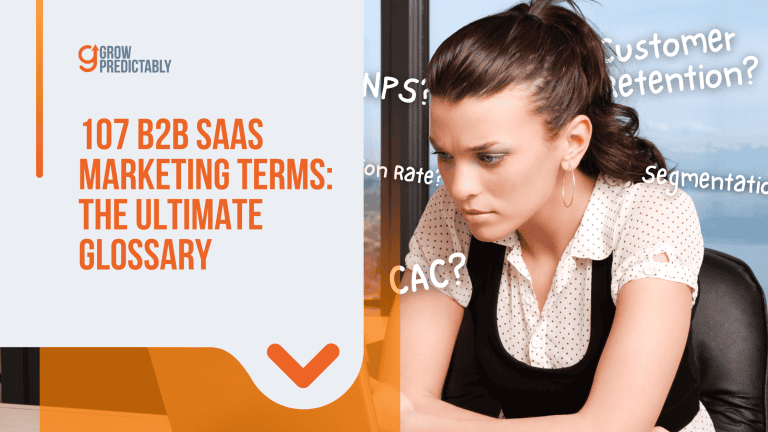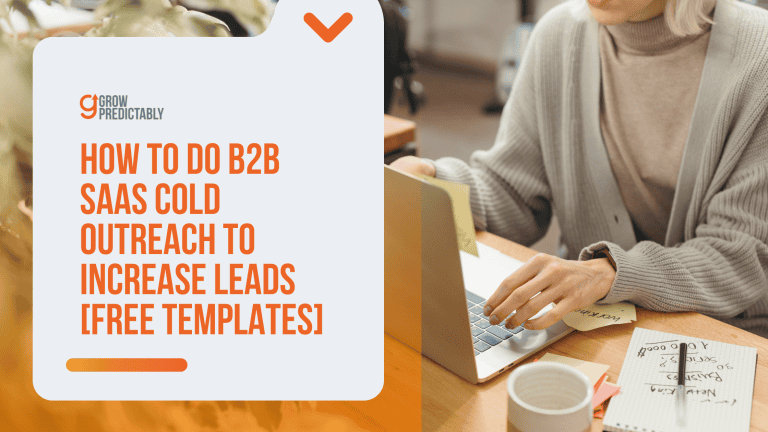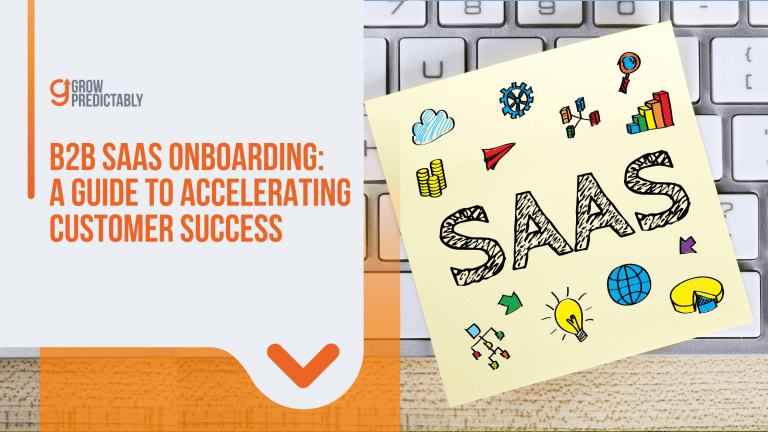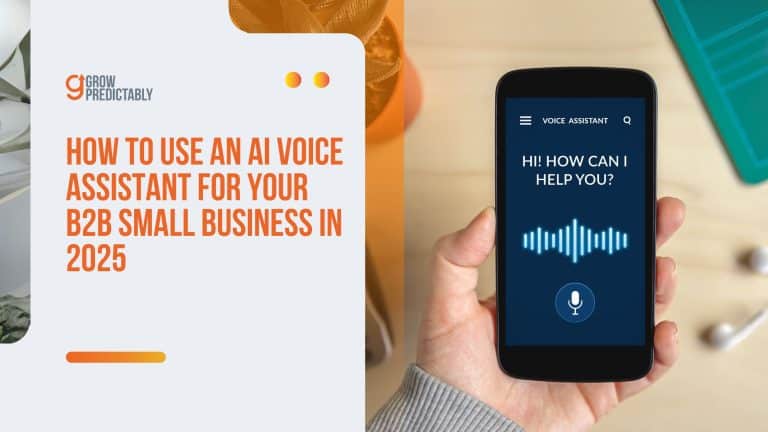The Basics of Effective Social Media Marketing for B2B SaaS
If you’re running a B2B SaaS company, you’re probably on LinkedIn, Twitter, or even YouTube.
But are you actually seeing results?
Most B2B SaaS brands post regularly yet struggle to build meaningful connections or drive pipeline.
That’s because they skip a crucial step in building a strategic social media presence.
Fix this gap, and you’ll see higher engagement, more qualified leads, and a stronger brand.
Wondering what that step is?
Let’s get into it.
Understanding the B2B SaaS Social Media Landscape
Navigating the B2B SaaS social media landscape involves understanding why people flock to these platforms.
Primarily, individuals use social media for connection, entertainment, and information.
B2B SaaS businesses surfacing here tap into a vast user base eager for engaging content and valuable insights.
Data indicates a growing trend of B2B companies leveraging social media to boost brand visibility and foster customer relationships.
With 75% of B2B buyers using social media channels for decision-making, the potential is undeniable. (Source)
B2B marketers should align their strategies with these core user motivations: create content that connects emotionally, entertains thoughtfully, and informs effectively.
By doing so, brands can elevate their social media presence, influencing their target audience while driving meaningful business results.
The key is to understand the audience’s needs and to curate content that delivers real value within the digital sphere.
The fundamentals of social media marketing encompass several key elements:
Strategy Development
Define clear goals, target audience, and the platforms most suitable for reaching them. A cohesive social media marketing strategy aligns with your overall business objectives.
Content Creation
Produce engaging, relevant, and high-quality content tailored to each platform. This includes visuals, text, and multimedia that resonate with your audience and support your brand identity.
Community Engagement
Actively interact with your audience through comments, shares, and direct messages. Building relationships fosters community and trust around your brand.
Analytics and Monitoring
Use social media management tools to track performance, understand audience behavior, and refine your strategy. Regular monitoring helps identify trends and measure success against goals.
Advertising and Promotions
Leverage paid advertising to expand reach and target specific demographics. Promotions should be strategic, aiming to convert followers into customers.
Consistency and Scheduling
Maintain a consistent posting schedule to keep your audience engaged and informed. Tools for scheduling can help manage content distribution efficiently.
Brand Voice and Messaging
Establish a distinct and consistent voice that aligns with your brand values and appeals to your audience. This helps in creating a recognizable brand presence.
Influencer Collaboration
Partner with influencers to extend your reach and add credibility to your brand. Influencers can be powerful advocates when aligned with your brand values.
Understanding these helps businesses effectively leverage social media to enhance their brand presence, engage with their audience, and drive business growth.
Building on the understanding of the B2B SaaS social media landscape, it’s essential to recognize how businesses can strategically navigate this space to maximize engagement and conversion within their social media marketing strategy.
This naturally leads us to explore the Customer Value Journey in B2B SaaS social media, a step-by-step approach that guides potential customers from their initial awareness of a brand through to advocacy.
The Customer Value Journey in B2B SaaS Social Media
By understanding and implementing this powerful SaaS social media marketing tool, businesses can create targeted social media maneuvers that not only sustain interest but also foster robust customer relationships.
To do this, the Customer Value Journey Framework helps you guide your potential customers through eight different stages, as seen in the infographic below.

Let’s break down how the Customer Value Journey works in social media for B2B SaaS brands:
1. Awareness
- Share thought leadership content showing industry expertise
- Post educational content about the broader industry challenge
- Example: Slack shares remote work insights, not just product features
2. Engagement
- Start conversations through polls and questions
- Share customer success stories
- Example: HubSpot’s LinkedIn polls regularly get 1000+ votes by asking relevant industry questions
3. Subscribe
- Offer valuable downloads (white papers, research)
- Host webinars addressing specific pain points
- Example: Zoom’s webinar series during COVID-19 helped them build massive email lists
4. Convert
- Share product demo snippets
- Post customer testimonials
- Example: Monday.com uses short video clips showing specific use cases
5. Excite
- Welcome new customers publicly
- Share onboarding tips
- Example: Asana’s Twitter feed celebrates customer wins
6. Ascend
- Highlight advanced features
- Share power user tips
- Example: Salesforce’s #AwesomeAdmin program spotlights expert users
7. Advocate
- Feature customer stories
- Create user communities
- Example: Notion’s ambassador program turns users into advocates
8. Promote
- Enable user-generated content
- Support customer referral programs
- Example: Dropbox’s referral program went viral on social media
Common Pitfalls in B2B SaaS Social Media
Here are common pitfalls every B2B marketer must watch out for in order to generate the best social media marketing results:
- Posting without strategic purpose
- Focusing on features instead of solutions
- Ignoring audience engagement
- Being too promotional
Now that you understand the landscape, I’ll show you how to craft content that moves prospects through each stage.
I’ve seen companies triple their engagement by following these stages thoughtfully instead of posting randomly.
REMEMBER: SaaS social media marketing isn’t about quick wins – it’s about building trust and showing expertise over time.
Each stage of the journey needs different content types and approaches to effectively implement your social media strategy and move prospects forward.
Crafting a B2B SaaS Social Media Marketing Strategy
Content is paramount in social media marketing, serving as the backbone for engagement and brand storytelling.
Notably, 80% of marketers view content creation as a top priority. (NYT Licensing)
Effective content captivates audiences, drives interaction, and fosters trust.
Let’s break down how to build your winning strategy using the Growth Scorecard framework.
The Growth Scorecard is a vital tool for B2B marketers, as it tracks key performance indicators (KPIs) across the customer journey—take a look at the example below.
By providing actionable insights, it aids in optimizing strategies and identifying bottlenecks.

Its focus on weekly tracking and real-time updates allows marketers to make swift, data-driven adjustments, which are crucial for crafting a responsive and effective social media marketing strategy.
Here’s how you can leverage this framework to ensure a strategic approach to social media marketing.
Setting Your Foundation
First, map your social media goals to specific stages in your customer’s journey:
- Awareness: Track new profile visits and followers
- Engagement: Monitor post interactions and click-through rates
- Subscribe: Count email sign-ups from social traffic
- Convert: Measure demo requests and sales conversations
- Excite: Track positive comments and shares
- Ascend: Monitor upsell interest signals
- Advocate: Count customer testimonials
- Promote: Track referral mentions
Weekly Check-Up System
Use this red-yellow-green status approach:
🔴 Red: More than 20% below target
🟡 Yellow: Within 20% of target
🟢 Green: Meeting or exceeding target
Pick 2-3 key metrics for each stage.
Check them weekly.
This quick system helps spot problems early and track key metrics effectively.
Avoiding Common Pitfalls
I’ve seen too many SaaS companies chase vanity metrics like follower count.
Instead, focus on engagement rates and conversion signals.
For example, one client stopped posting generic updates and started sharing customer success stories – their demo requests doubled in one month.
Key Strategy Components:
- Content Mix: 60% educational, 30% engaging, 10% promotional
- Platform Focus: Pick 2 main channels where your buyers spend time
- Posting Schedule: Consistency beats frequency
- Response Time: Aim for under 2 hours during business hours
Implementation Steps:
- Build your scorecard (template below)
- Set realistic weekly targets
- Track numbers every Friday
- Adjust tactics based on red/yellow signals
- Review and reset targets monthly
Here’s a simple scorecard template:
| Stage | Metric | Target | Actual | Status |
|---|---|---|---|---|
| Awareness | Profile Visits | 500 | 450 | 🟡 |
| Engage | Post Comments | 50 | 20 | 🔴 |
| Convert | Demo Requests | 10 | 12 | 🟢 |
Now that you’ve got your strategy framework in place, let’s move on to optimizing your social profiles to maximize these metrics.
The 2 Best Social Channels for B2B Marketing
As B2B marketers, you go further by knowing that not all social media platforms will serve your business objectives.
However, for your top options, LinkedIn and X have emerged as the top social platforms for engaging with industry professionals.
According to Social Shepherd, 96% of B2B marketers use LinkedIn for their organic social marketing strategies, making it a goldmine for B2B marketers. (Source)
Its user base primarily consists of decision-makers and industry experts, fostering an environment conducive to professional interaction and thought leadership.
Unique features such as LinkedIn Groups and LinkedIn Pulse allow brands to share expert insights and utilize a professional networking platform effectively

B2B brands like HubSpot, Salesforce, and Microsoft excel on LinkedIn by sharing insightful content and engaging with professionals.
X (Formerly Twitter)
X, on the other hand, offers real-time engagement and widespread visibility.
It allows businesses to disseminate industry news quickly, join trending discussions, and establish thought leadership with 82% of B2B marketers seen to use X for SaaS social media marketing to ‘share their latest content, promote offerings, and connect with their target audience.’ (Source)
The platform’s unique hashtags facilitate discovery and context around key topics.

B2B giants like IBM, Oracle, and Adobe leverage social platforms like X to engage with their audiences through timely updates and by participating in industry conversations.
Both platforms offer invaluable opportunities for a B2B SaaS business to connect with their audience, share expert knowledge, and drive engagement.
Embracing these platforms will undoubtedly enhance a SaaS business’s digital presence and credibility in the B2B space.
Optimizing Your Social Media Profiles for B2B SaaS
Think of your SaaS business’s social media profile as your digital storefront
Just like you’d polish your shop window, your online presence needs the same care.
Let’s break down the essential steps to optimize your profiles:
1. Profile Branding Excellence
Update your banner image with your value proposition.
Use a professional headshot or logo (aim for 80% face visibility in personal profiles).
Write headlines that speak to your ideal customer’s pain points.
Include relevant keywords naturally in your descriptions.
🟥 Red Flag: Generic company descriptions.
🟩 Green Signal: “We help B2B companies automate their marketing workflows, saving 15+ hours per week”.
2. Audience-Focused Positioning
Craft your bio around customer outcomes, not company features.
Share specific results and numbers when possible.
Include clear calls-to-action.
List relevant certifications and awards.
🟥 Red Flag: “We’re a leading SaaS platform”.
🟩 Green Signal: “Helping 1,000+ marketing teams cut reporting time by 50%”.
3. Strategic Engagement Setup
Pin your best-performing content.
Highlight case studies in featured sections.
Enable relevant profile features (e.g., LinkedIn Creator Mode for thought leadership).
Set up custom CTAs that align with your funnel.
4. SEO Optimization
Research and include industry-specific keywords.
Use location-based terms for regional targeting.
Add relevant hashtags to increase discoverability.
Link to your website and other social profiles.
Tracking Your Marketing Strategy Progress
Track your progress weekly using this simple system:
🔴 Red: Profile needs immediate attention.
🟡 Yellow: Making progress but needs work.
🟢 Green: Optimized and performing well.
Here’s a real example from my experience: A client’s LinkedIn company page was stuck at 🔴 (Red) according to their Growth Scorecard because of generic messaging.
After implementing these changes, focusing on customer outcomes and adding specific success metrics, they moved to 🟢 (Green) within three weeks, resulting in a 40% increase in profile visits and double the inbound messages.
Weekly Metrics Check
Remember to check these metrics weekly:
- Profile view growth
- Connection/follower request quality
- Engagement on posts
- Inbound message relevance
Speaking of engagement, I’m excited to show you how to create content that turns these optimized profiles into lead-generating machines.
But first, let’s make sure your profiles are ready.
Take 30 minutes today to audit your current profiles against this checklist.
A Quick Audit of Your Social Media Profiles
Here’s a simple checklist to help optimize your social media profiles for B2B SaaS based on the provided content:
Profile Branding Excellence
⬜ Update banner image with a clear value proposition
⬜ Use a professional headshot or logo with 80% face visibility for personal profiles
⬜ Write headlines addressing your ideal customer’s pain points
⬜ Include relevant keywords naturally in descriptions
⬜ Avoid generic company descriptions; be specific
Audience-Focused Positioning
⬜ Craft bio focused on customer outcomes instead of company features
⬜ Include specific results and numbers in the bio
⬜ Add clear calls-to-action (CTAs)
⬜ List relevant certifications and awards
Strategic Engagement Setup
⬜ Pin best-performing content on your profile
⬜ Highlight case studies in the featured sections
⬜ Enable relevant profile features (e.g., LinkedIn Creator Mode)
⬜ Set up custom CTAs aligned with your funnel
SEO Optimization
⬜ Research and include industry-specific keywords
⬜ Use location-based terms for regional targeting
⬜ Add relevant hashtags to increase discoverability
⬜ Link to your website and other social profiles
Weekly Metrics Check
⬜ Track profile view growth weekly
⬜ Evaluate the quality of connection/follower requests
⬜ Assess engagement levels on posts
⬜ Monitor relevance of inbound messages
Completing this checklist will ensure that your social media profiles are well-positioned to influence and engage your B2B audience effectively.
Want to see how the top B2B SaaS companies are structuring their social content?
Stay tuned for our next section on creating engaging content that converts.
Creating Engaging Content for B2B SaaS Audiences
Picture this: You’ve spent hours crafting what you think is the perfect social post about your SaaS product’s features, but it barely gets any engagement.
Sound familiar?
You’re not alone – many B2B SaaS companies struggle to create content that truly connects.
Drawing from my experience working with SaaS clients, I’ve seen firsthand how shifting from feature-focused to problem-solving content can transform engagement rates.
Let’s break this down using the three essential social media marketing tools framework:
1. Customer Avatar Canvas
Start by getting crystal clear on who you’re talking to.
For B2B SaaS, this means understanding:
- Job Roles: Who makes buying decisions?
- Daily Challenges: What keeps them up at night?
- Content Preferences: Where do they hang out online?
For example, if you’re targeting IT Directors, they’re likely worried about security risks, system integration, and ROI.
Your content should speak directly to these concerns.
2. Core Message Canvas
This is where you turn features into stories that resonate.
Instead of saying “Our platform has automated workflow capabilities,” try “Imagine cutting your approval process from 2 weeks to 2 days.”
Key elements to include:
- Problem statements that mirror your audience’s language
- Success stories from similar companies
- Data points that back up your claims
- Clear, jargon-free explanations
From my corporate experience, I’ve found that mixing technical expertise with simple explanations works best.
For instance, one client saw 3x more engagement when they replaced technical jargon with simple “before and after” scenarios.
3. Value Journey Worksheet
Map your content types to each stage of the customer journey:
Awareness:
- LinkedIn thought leadership posts
- Educational Twitter threads
- Industry trend analysis
Engagement:
- Interactive polls about common challenges
- Short-form video tips
- Behind-the-scenes content
Subscribe:
- Free tools and templates
- Industry research reports
- Solution comparison guides
Convert:
- Customer success stories
- Product demo snippets
- ROI calculators
My testing shows that content mixing education with emotion performs best.
One SaaS company I worked with saw a 40% increase in demo requests after sharing customer transformation stories instead of feature lists.
✅ Do:
- Share real customer stories
- Use data to support claims
- Break down complex topics
- Show personality in your posts
❌ Don’t:
- Focus solely on features
- Use technical jargon
- Post without a clear goal
- Copy competitors blindly
Quick Win Tip
Start with one LinkedIn poll asking your audience about their biggest challenge.
Use the responses to guide your next month’s content.
This simple tactic helps you create content your audience actually wants.
Remember: Your B2B audience might wear a suit, but they’re still human.
They want content that makes them feel understood, helps them solve problems, and maybe even makes them smile.
Engaging Content Requires an Effective Content Calendar
For B2B SaaS marketers, having a well-structured content calendar is essential to ensure consistent and impactful SaaS social media marketing.
Here are three main focuses to keep in mind:
1. Audience-Centric Content
Always prioritize the needs and interests of your audience.
Develop content that addresses their pain points, answers their questions, and provides valuable insights.
Use customer feedback and data analytics to guide your content planning.
Remember, content that resonates with your target audience boosts engagement and strengthens connections.
B2B marketers can utilize the Customer Avatar Canvas to create detailed profiles of their ideal customers, considering demographics, psychographics, and specific needs.

By understanding their target audience through this framework, they can craft content that directly addresses customer pain points and aspirations, fostering deeper engagement and relevance.
The ‘Before/After’ step is particularly useful, as it highlights potential transformations, making the content more personal and impactful.
2. Channel-Specific Strategies
Different social media channels cater to different audiences and content types.
Tailor your content to fit each channel’s unique characteristics.
LinkedIn may suit in-depth articles and professional insights, while Twitter thrives on quick updates and engaging conversations.
Ensure your content calendar reflects these nuances for optimal reach and impact.
Let’s say you’re a B2B brand that helps your audiences improve productivity:
- LinkedIn: Share in-depth articles, case studies, and professional insights that demonstrate productivity tools’ application in real business scenarios.
- Twitter (X): Post quick tips and industry news updates, and engage with trending productivity topics to initiate conversations.
- YouTube: Create video tutorials, webinars, and demonstrations showcasing the product’s effectiveness, offering visual learners an engaging way to explore the tools.
3. Consistent Timing and Frequency
Consistency is key. Post regularly to maintain visibility and stay top-of-mind with your audience.
Use analytics to determine peak posting times for engagement.
A consistent schedule helps build trust, and an active presence keeps your audience engaged.
A B2B marketer can leverage analytics tools available within social media platforms or third-party applications to track audience engagement metrics.
These tools provide insights into when the audience is most active, detailing peak days and times based on past interactions, likes, shares, and comments.
For example:
A B2B marketer for a project management tool uses LinkedIn’s analytics and discovers that their audience—comprising mainly of mid-level managers and team leaders—is most active on weekdays, particularly between 10 AM and 12 PM.
They also note increased engagement during mid-week around 3 PM, likely when professionals are seeking new strategies to improve weekly performance.
With this data, the marketer creates a content calendar that schedules detailed case studies for LinkedIn every Tuesday and Thursday morning to align with these peak activity times.
Quick tips and infographics are scheduled for posting on Wednesday afternoons, coinciding with the secondary peak period.
This strategic timing maximizes content visibility and interaction, ensuring the company’s project management solutions remain top-of-mind for their target audience during key decision-making periods.
Always keep an eye on the engagements your content is receiving. Over time, tracking reactions to different posting times can refine the strategy, ensuring the content always lands at the most opportune moments for audience interaction.
Step-by-Step Guide for Creating a Content Calendar
A content calendar is a document that helps you plan what type of content to release on a specific date and time, it’s designed to help marketers strategize and organize their content in advance.
They’re basically calendars that focus on keeping you on top of posting different types of content within a certain period; for most social media marketing professionals, on a monthly timeframe.
Take a look at this example from SEMrush.

The content calendar you’re seeing has dates, assignees, status trackers, and more.
NOTE: Content calendars can look different from company to company. What’s important is for it to have different elements that help you track important details regarding your content.
Aside from having a clear picture of what a content calendar could look like, what else should you keEach stage of the journey needs different content types and approaches to move prospects forward.ep in mind when crafting your own content calendar?
Here are a few important things to remember in content and social media marketing:
- Set clear goals: Define what you want to achieve with your social media efforts.
- Research and brainstorm: Gather ideas based on industry trends and audience interests.
- Plan content themes: Align content with business objectives and seasonal events.
- Schedule posts: Use social media management tools like Buffer or Hootsuite to automate and track posting.
- Monitor and adjust: Regularly review analytics to refine strategies and optimize performance.
By focusing on these core elements and following a structured approach, B2B marketers can craft content calendars that drive results and enhance brand presence.
Now, do you want to see how effective your current content is?
Measuring Success in B2B SaaS Social Media Marketing
Did you know tracking the wrong metrics can mask real problems in your social media strategy?
I learned this firsthand when a client’s growing follower count hid their dropping demo conversion rates in their social media strategy.
Let’s fix that.
Think of measuring social media success like checking your car’s dashboard – you need the right gauges to know if you’re really moving forward.
Here’s how to track what matters using the Growth Scorecard framework:
Awareness Stage
- Weekly follower growth rate (aim for 3-5% growth)
- Post impressions (track against your baseline)
- Content reach (% of target audience reached)
Engagement Stage
- Comment rate (industry average: 0.5-1% per post)
- Share rate (benchmark: 0.2-0.5% for B2B content)
- Click-through rates (target: 1-3% for B2B posts)
Subscribe Stage
- Lead magnet conversion rate (aim for 20-30%)
- Email opt-in percentage (industry standard: 2-5%)
- Landing page bounce rates (keep under 60%)
Convert Stage
- Demo request rate from social traffic
- Sales conversation initiation rate
- Social media attribution in closed deals
Advancing Stages (Excite → Promote)
- Client retention rates from social-sourced leads
- Testimonial sharing rate
- Client referral rates
Weekly Performance Tracking System
Use this simple Red-Yellow-Green system to spot issues fast:
- 🔴 Red: Below 80% of target
- 🟡 Yellow: 80-95% of target
- 🟢 Green: Above 95% of target
From my experience helping SaaS companies, checking these metrics weekly beats monthly reviews.
You can catch drops in engagement before they hurt your pipeline.
Real-World Impact
Take my client in the project management software space.
Their weekly tracking revealed their LinkedIn posts got lots of likes but few demo requests.
By shifting focus to problem-solving content, their demo requests jumped 40% in one month.
Remember: fancy dashboards don’t equal better results.
Start with these core metrics, track them consistently, and adjust based on what the data tells you.
But first, make sure you’ve got these foundational measurements in place.
FAQs
The Strategic Path to SaaS Social Media Success
Mastering B2B SaaS social media isn’t just about posting regularly—it’s about strategically guiding potential customers through their journey.
By applying the Customer Value Journey framework, we’ve seen how businesses can boost engagement, increase demo requests, and build lasting relationships.
Social media is more than a marketing channel; it’s a powerful tool for trust-building. Are you making the most of yours?
Start by auditing your content strategy today—are you addressing each stage of the journey? If not, take action now to fill in the gaps.
For more insights, check out The Ultimate Guide to B2B SaaS Content Marketing for deeper strategies on engaging your audience.
What stage do you think your social media efforts struggle with the most? Drop a comment below—I’d love to discuss how you can improve!








